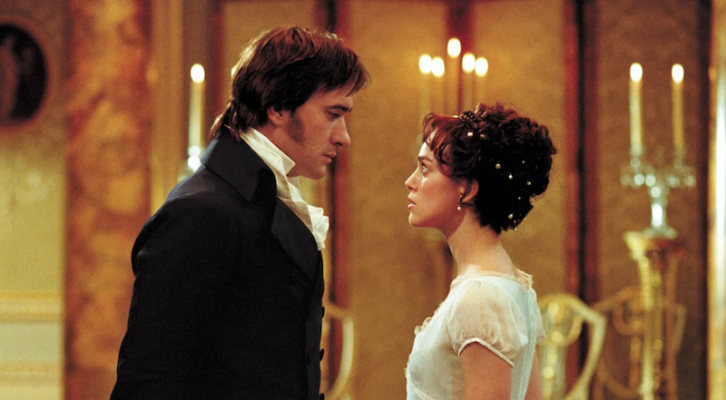
The Pleasure and Communion of Austen's Country Dance
Cornelia Powers Considers "the Felicities of Rapid Motion"
Last summer as my husband and I were exploring the West End of Edinburgh, we stumbled upon a Gaelic country dance or “cèilidh” on the grounds of St. Mary’s Cathedral—the tallest building in the Scottish capital. To the tune of live fiddles and flutes, the dancers transfixed us with their progressive rings and intricate steps, which they all seemed to know by heart. At one point, I half-expected Mr. Darcy to join in, repeating the question he asks Elizabeth Bennet at Netherfield after hearing a “lively Scotch air”:
“Do you not feel a great inclination, Miss Bennet, to seize such an opportunity of dancing a reel?”
As in all of her novels, Jane Austen uses dancing in Pride and Prejudice as a “certain step toward falling in love.” Even for those like Mr. Darcy who claim they have “not the least intention” of joining in, the dance serves as an invitation and a watershed—a thrill whose rhythms, tempos, and gestures mirror the crescendos and diminuendos of Regency-era courtship. While specific to the early nineteenth century, the dancing in Austen’s novels dates back to the reign of Queen Elizabeth I, who is said to have favored provincial routines over more balletic numbers like the minuet and the louvre. With the publication of The English Dancing Master in 1651, bookseller John Playford took to codifying these so-called “country dances.” And over the next two hundred years, they were published regularly across the United Kingdom, encompassing thousands of dances and tens of thousands of variations.
While performing these dances, couples would assemble in “longways” sets spaced some four feet apart, with men and women standing opposite each other before moving through a series of synchronized figures or “rings.” Every so often, participants would indulge in a cèilidh like the ones referenced in Pride and Prejudice, clapping their hands to the tune of “Scotch and Irish airs” before the men in the room would issue a full-throated yell or “heuch.”
By the turn of the nineteenth century, country dances like “Haste to the Wedding,” “Fox and Geese,” “Peace and Plenty,” and “Will O’ the Wisp” had created their own language marked by infinite letters, words, and arrangements. Twentieth-century music critic Frank Kidson likened them to games of chess whose motions resembled “another in general principle, but not in detail,” ever-changing their direction, sequence, and pace. As a workout, an intellectual exercise, and a veritable mating ritual, they demanded thought and practice as well as a certain “x” factor—as indefinable as it was filled with soul.
From Bath to Meryton to the Crown Inn, Austen employs dancing as a precursor to and a metaphor for marriage, choreographing each dance as an experiment in which the “man has the advantage of choice” and the woman has “the power of refusal.” As many scholars have noted, the dancing in her novels is reserved for the aerobically fit, leaving even young participants like Mansfield Park’s Fanny Price “breathless, and with her hand at her side.” With steps and tunes selected by the noblest woman in each room, it offers female characters a way to exercise power—such as when Emma’s Emma Woodhouse says to Mr. Knightley that “I am ready, whenever I am wanted”—while also serving as a proxy for class. Surely, whereas Mr. Collins’ clumsy dancing in Pride and Prejudice signals a lack of tact and self-awareness—suggesting that he is a partner to avoid—characters like Mr. Darcy and Mr. Knightley are praised for their “superior dancing” and “natural grace.” “It is evident,” says Sir William Lucas to Mr. Darcy after watching him dance at Netherfield Ball, “that you belong to the first circles.”
In Austen’s universe, the country dance anticipates a person’s willingness to court and eventually marry. Across all of her novels, perhaps no one believes this more firmly—or says this more explicitly—than Northanger Abbey’s Henry Tilney. In speaking with love interest Catherine Morland, he defines the country dance as “an emblem of marriage,” insofar that both are “an engagement between man and woman, formed for the advantage of each.” As Tilney sees it, marriage and dancing are marked by not only “complaisance”—with each party endeavoring “to give the other no cause for wishing that he or she had bestowed themselves elsewhere”—but also “fidelity,” with each doing his or her best to keep one’s eyes from “wandering.”
By contrast, the dancing in Austen’s novels can also represent an unwillingness to marry. Much like Mr. Darcy refuses to dance at Meryton, claiming that there are no women “handsome enough to tempt me,” Mr. Knightley insists on remaining with the “standers-by” at the Crown Inn, leading Emma to lament his “provoking indifference” while wishing that he “could love a ballroom better.” Perhaps the harshest in his disinclination is Persuasion’s Captain Wentworth, who at one point argues that his former flame Anne Elliot belongs at the pianoforte and not on the dance floor with the other, livelier couples.
Once the “felicities of rapid motion” have been felt, it is hard—perhaps even impossible—not to “ask for more.”
Of course, the country dance can also mimic a change in perspective and a receptivity to change. With each encounter, Austen’s characters rehearse what Langdon Elsbree calls a dance of “reassessment and maturity.” Placed on either side of a set, they chassé back and forth, creating periods of connection followed by periods of misunderstanding and separation. In time, they adjust to the dance’s changes in rhythm and tempo, becoming more mindful of their and their partner’s movements until they become part of themselves, like a secret language only they can speak.
As Carol Shields writes in her biography of Austen, it is highly unlikely that the author ever had a sexual relationship. As a person, she held rather conventional views on marriage and courtship; and as a writer, she seldom even mentions the body. In all of her novels, she elevates the brain while glossing over her characters’ physical wants and needs, often proffering balls and assembly rooms as the only sites for premarital contact. In the 206 years since her death, Austen has been lambasted for this so-called “want of body.” “What sees deeply, speaks aptly, moves flexibly, it suits her to study,” Charlotte Brontë wrote in 1850. “But what throbs fast and full, though hidden, what the blood rushes through, what is the unseen seat of Life and the sentient target of death—this Miss Austen ignores.”
Yet as Shields reminds us, Austen’s disinterest in the body was more a byproduct of the era in which she lived than any personal or religiously inspired aversion. As a young woman, she loved to dance and filled the pages of her juvenilia with tales of scandal and seduction. Certainly, Austen was no prude, and neither are her heroines. On and off the dance floor, they move to a subtle sensuality that pulses below the surface, creating an irresistible tension that adds to—rather than detracts from— our interest in them. When Mr. Darcy first dances with Elizabeth, we are told that “such very superior dancing is not often seen”; their chemistry is apparent to everyone, especially the begrudging Caroline Bingley. Likewise in Emma, when Mr. Knightley presses Emma’s hand against his heart and her cheeks begin to glow, we understand that we are watching a great passion unfold, even as everyone remains fully clothed.
Still, Austen makes sure that it is her heroines’ intelligence that secures the “fidelity and complaisance” of the men who fall for them. Mirroring the complexity and subtlety of the country dance, Elizabeth, Emma, Anne, Catherine, Fanny, and Elinor find their footing in language and reason. They are not the sort of “elegant female[s]” who aim to seduce and “plague,” as Elizabeth Bennet says to Mr. Collins, but rather “rational creature[s]” who know and speak the truth.
For viewers of modern-day adaptations of Austen’s novels and other period pieces like Bridgerton, the sight of the country dance can incite a mix of awe and envy. Each step, twirl, and do-si-do reflects a collective social feat—too vast to be comprehended—while each tantalizing touch serves as a reminder of what we have lost. It has been suggested that contemporary interest in Jane Austen has been spurred—at least in part—by an over-exposure to the body and a renewed appreciation for the “slow burn.” It is as though by living vicariously through Austen’s characters that we are able to reinhabit a long-lost world where patterns of social intercourse were more formal and delayed—yes—but also more joyful.
After Jane Austen’s death in 1817, the country dance was gradually succeeded by the waltz and other “closed couple” dances like the quadrille and the polka and—later—the foxtrot and the Charleston. A century on, we are rarely offered any such lifeline. At parties and weddings, we dance like cups of Jell-o, ever-unsure with what to do with our puckered lips and T-Rexified hands. Every so often, a DJ may throw us a bone in the form of the “Macarena” or the “Cha-Cha-Slide.” Yet these dances feel curiously disembodied, with each person moving in his or her own little bubble, never to interact.
Over the past few years, many have taken to participating in online “dance challenges” on Instagram and TikTok. Similar to the country dance, the synchrony of these challenges has been shown to be good for our health by helping us restore a sense of physical equilibrium. Even so, I question whether the “Toosie Slide” and “Don’t Start Now” can do for us what “Kiss Me Early” and “All in a Garden Green” did for Mr. Darcy and Elizabeth Bennet. No matter how challenging, enjoyable, or synchronous, they confine our dancing to our screens, further disconnecting us from each other as well as ourselves.
Recently, country dancing has experienced something of a revival, with societies popping up across North America and the UK. As evidenced by the scores of other passersby who joined me and my husband in watching the Edinburgh cèilidh a year ago—our faces all smiling, our toes all tapping—the country dance manages to retain a hold over us. In offering a portal into another time, it allows us to participate in an act of gentle defiance against a culture that can feel so commodifying and divisive. It allows us to feel human again, perhaps in ways we did not even know we needed.
We may all pass “many months successively, without being at any ball of any description, and no material injury [will] accrue either to body or mind,” Emma Woodhouse reminds us.
But once the “felicities of rapid motion” have been felt, it is hard—perhaps even impossible—not to “ask for more.”
Cornelia Powers
Cornelia Powers is a DC-based writer whose work has been featured in Time, Harper’s Bazaar, New York Magazine, The Washington Post, and The Chicago Review of Books. She is currently working on her first book, an ancestral memoir about her great-great-grandmother.



















